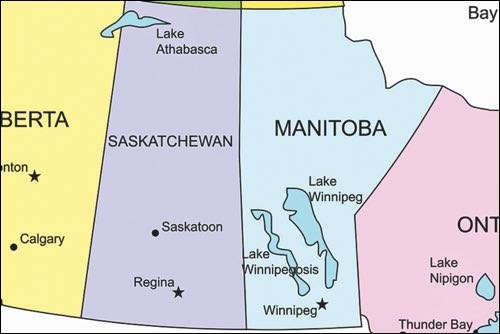Residents of Saskatchewan and Manitoba may disagree over which province makes a better home, but the statistics speak for themselves: Manitobans seem to be better off financially.
According to numbers collected by Statistics Canada in 2016, Manitobans are spending more money in just one of 17 categories analyzed by the data-collection agency.
“We’re always looking at those comparatives with Saskatchewan being our neighbouring province and being the most like Manitoba,” said Chuck Davidson, president and CEO of the Manitoba Chamber of Commerce. “When we’re looking at attracting companies to this province, those numbers are very important, and I believe Manitoba
does well.”
The Statistics Canada figures show that compared to Saskatchewanians, Manitobans spent roughly $12,000 less to live day to day in 2015.
And although the average income in Manitoba was about $6,000 less than in Saskatchewan, Manitobans kept more of their money, earning about $4,000 more than they spent.
In Saskatchewan, the average income of $86,970 was more than eaten away by $89,938 in expenditures. Manitobans spent an average $77,043 through the year, but earned $80,940.
Manitobans spent $13,397, or 16.5 per cent of earnings, on income tax, compared to $16,026, or 18.4 per cent, in Saskatchewan.
Manitobans spent $14,760 on shelter compared to $17,146 in Saskatchewan; and $4,085 on household operations compared to $4,958.
Manitobans spent $11,682 on transportation compared to $15,237 for Saskatchewanians; and $3,896 on recreation compared to $4,792.
The only category where Manitobans spent more money was in the area of personal care – $1,294 compared to $1,273, a difference of just $21.
It should be noted that these statistics will have changed since their collection a year ago.
Meanwhile, average auto insurance rates were also slightly less in Manitoba, at $1,027 per year for Manitoba Public Insurance (MPI) as compared to $1,049 for Saskatchewan Government Insurance (SGI).
And despite the recent rate increase in Manitoba, Saskatchewan residents are still paying more for electricity.
The current price of residential power from SaskPower is $137.40 per 1,000 kilowatt hours (kWh). Manitoba Hydro’s residential customers pay $81.96 per 1,000 kWh.
Davidson, the Manitoba Chamber president, suggested a cost-of-living comparison between any provinces is endlessly variable given the range of incomes and expenditures incurred by the wide array of people that make up each province’s population.
However, when looking at the averages, it does appear Manitoba stands above Saskatchewan.
“Manitoba is a lot more cost-effective and that’s a benefit to us,” Davidson said. “I’m sure the government of Saskatchewan keeps a close watch on this.
“When you look at the cost of living, there are so many factors that need to be taken into consideration . . . When you look at take-home pay and provincial sales tax and income tax levels – and the fact that, in some cases, the taxes are at a higher level – that seems to be the equalizer. It might seem the cost of living is lower, but the take-home pay in some cases is different. There are additional costs that are not as negative on the pocketbooks in places like Saskatchewan and Alberta.”
Davidson noted Saskatchewan’s growth in recent years has been “a double-edged sword.”
While the economy and population of Saskatchewan has grown, so has the cost of housing, transportation, infrastructure maintenance and other categories financed through private and public coffers.
But this growth is the very reason Saskatchewan carries a slight advantage over Manitoba, says Curtis Hemming, director of government relations for the Saskatchewan Chamber of Commerce.
Hemming suggested the cost of living in Manitoba may be less due to its economic base of agriculture, manufacturing, tourism and the retail industry.
Some of these industries – specifically retail sales – produce lower-paying jobs that do not allow average residents to spend more.
Saskatchewan, meanwhile, has a broader number of natural resources to draw from, producing higher-paying jobs in industries such as mining and their spin-off businesses.
“[Manitoba has] an advantage over Saskatchewan because they have a lot of hydro power,” Hemming said. “Here, we have to get all of our power from natural gas and coal. But there’s a lot more [heavy industry] here with natural gas, oil, potash and rare earth minerals [uranium, lithium] that provide a substantial advantage. Manitoba has fewer natural resources but [has] manufacturing, farming and tourism, which provides a different basket of economic factors.”
Hemming admitted that large expenses, such as housing, do cost more in Saskatchewan, but that is due to a high demand from people who are seeking better income opportunities moving to the province throughout the past decade.
“Manitoba might have less expensive houses, but you have to take the weaker economy and fewer opportunities to go along with those house prices,” said Hemming, adding this also stands true in comparison with other provinces, such as those on Canada’s East Coast.
“In Manitoba, when the NDP was in power, they weren’t doing poorly, but you could see the luster on Saskatchewan a lot clearer, and I think fewer people were moving to Winnipeg, Brandon and Dauphin, which meant lower housing prices.”
Saskatchewan’s exploding job market since 2008 – and the higher pay provided by those positions – is instrumental in the statistics seen in the cost of living between provinces, he said.
“I can’t think of any retail job where you can come even close to a resource-extraction job across the board, whether you’re working in accounting, human resources, sweeping the floors or operating a piece of mining equipment,” said Hemming.




